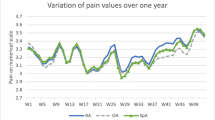Abstract
A point process model is suitable for analysis of a sequence of binary variables, each of which may be dependent on the preceeding one. This model was used for analysis of the correlation between the state of the atmosphere and the presence or absence of asthmatic symptom known from diaries in which a day was divided into four parts. The diaries were kept during summer and autumn of a year by 19 adult and 12 child patients in Sapporo (43°03′ N, 141°20′ E), 39 adult and 20 child patients in Tokyo (35°41′ N, 139°46′ E), and 26 adult and 18 child patients in Naha (26°14′ N, 127°41′ E).
Low temperature and decrease in temperature significantly related to the asthmatic symptom during the seasons. No reversions on correlations as to temperature were observed among places, between the adult and the child, and before and after taking in effects of the preceding symptom and/or the circadian rhythm. Some correlations relating to humidity or to barometric pressure, on the other hand, reversed from place to place, from the adult to the child, and from “before” to “after” taking in the effects.
Availability of this model for further study on the correlation between the air with contents and the asthmatic symptom is shortly discussed.
Similar content being viewed by others
References
Hinds WC (1982) Aerosol Technology. Hohn Wiley New York
Jones WHS (1923) Air water places. In: Jones WHS (eds) Loeb classical library, Hippocrates, vol 1. Harvard University Press, London, 65–137
Korn EL, Whittemore AS (1979) Methods for analyzing panel studies of acute health effects of air pollution. Biometrica 35:795–802
Rahn KA, Dams R, Robbins JA, Winchester JW (1971) Diurnal variations of aerosol trace element concentrations as determined by nondestructive neutron activation analysis. Atmos Environ 5:413–422
Ramsey JM (1977) Time course of bronchoconstrictive response in asthmatic subjects to reduced temperature. Thorax 32:26–28
Rodriguez-Martinez F, Mascia AV, Millins RB (1973) The effect of environmental temperature on airway resistance in the asthmatic child. Prediatr Res 7:627–623
Suzuki S, Tadokoro K, Takeuchi F, Miyamoto T, Kamakura T (1986) Acute effects of meterological conditions on asthma frequencies. J Jpn Assoc Phys Med Balneol Climatol 49:139–149
Swantes HJ, Lamsfuss J (1981) Historische Beobachtungen über den Wetter- und Klimaeinfluss. Med Welt 32:1802–1807
Swartz H (1957) Climate and asthma. NY State J Med 57:273–276
Tromp SW (1968) Influence of weather and climate on asthma and bronchitis. Rev Allergy 22:1027–1044
Watanabe N, Yoshida R, Yanagimoto T (1984) Methods for analysing acute effects of air pollutants and weather conditions on childhood asthma. Jpn J Allergol 33:868–878
Author information
Authors and Affiliations
Rights and permissions
About this article
Cite this article
Suzuki, S., Kamakura, T., Tadokoro, K. et al. Correlation between the atmospheric conditions and the asthmatic symptom. Int J Biometeorol 32, 129–133 (1988). https://doi.org/10.1007/BF01044906
Received:
Issue Date:
DOI: https://doi.org/10.1007/BF01044906




